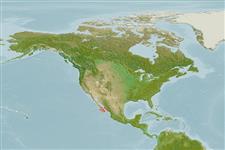Environment: milieu / climate zone / depth range / distribution range
Ecología
marino asociado a arrecife; rango de profundidad 0 - 10 m (Ref. 57883). Tropical; 26°N - 23°N (Ref. 57883)
Eastern Central Pacific: around the southern tip of the Gulf of California.
Tamaño / Peso / Age
Maturity: Lm ? range ? - ? cm
Max length : 7.8 cm SL macho / no sexado; (Ref. 57883)
Radios blandos dorsales (total): 78-91; Radios blandos anales: 56 - 65; Vértebra: 42 - 45. The species is characterized by the following: Vertebrae 11-13 + 30-33 = 42-45, dorsal fin rays 78-91, anal fin rays 56-65, the outer pseudoclasper broad, distally expanded; inner pseudoclasper branched into three slender branches, two outer v-shaped, medial one short and stout, penis with abrupt change from thick base to thin tip; opercular spine with single, sharp tip; scales on cheek small, in vertical 7-9 rows (Ref. 57883).
Common species (Ref. 34024). Found in rocky crevices (Ref. 11482).
Life cycle and mating behavior
Madurez | Reproducción | Puesta | Huevos | Fecundidad | Larva
Møller, P.R., W. Schwarzhans and J.G. Nielsen, 2005. Review of the American Dinematichthyini (Teleostei: Bythitidae). Part II. Ogilbia. aqua, J. Ichthyol. Aquat. Biol. 10(4):133-207. (Ref. 57883)
IUCN Red List Status (Ref. 130435)
Threat to humans
Harmless
Human uses
Pesquerías: sin interés
Más información
ReferenciasAcuiculturaPerfil de acuiculturaRazasGenéticaElectrophoresesheritabilidadEnfermedadesProcesamientoNutrientsMass conversion
ColaboradoresImágenesStamps, Coins Misc.SonidosCiguateraVelocidadTipo de nataciónSuperficie branquialOtolitosCerebrosVisión
Herramientas
Special reports
Download XML
Fuentes de Internet
Estimates based on models
Preferred temperature (Ref.
123201): 23.2 - 26.3, mean 25.1 °C (based on 31 cells).
Phylogenetic diversity index (Ref.
82804): PD
50 = 0.5000 [Uniqueness, from 0.5 = low to 2.0 = high].
Bayesian length-weight: a=0.00389 (0.00180 - 0.00842), b=3.12 (2.94 - 3.30), in cm total length, based on all LWR estimates for this body shape (Ref.
93245).
Nivel trófico (Ref.
69278): 3.3 ±0.5 se; based on size and trophs of closest relatives
Resiliencia (Ref.
120179): Bajo, población duplicada en un tiempo mínimo de 4.5-14 años (Assuming Fec < 100).
Fishing Vulnerability (Ref.
59153): Low vulnerability (10 of 100).
